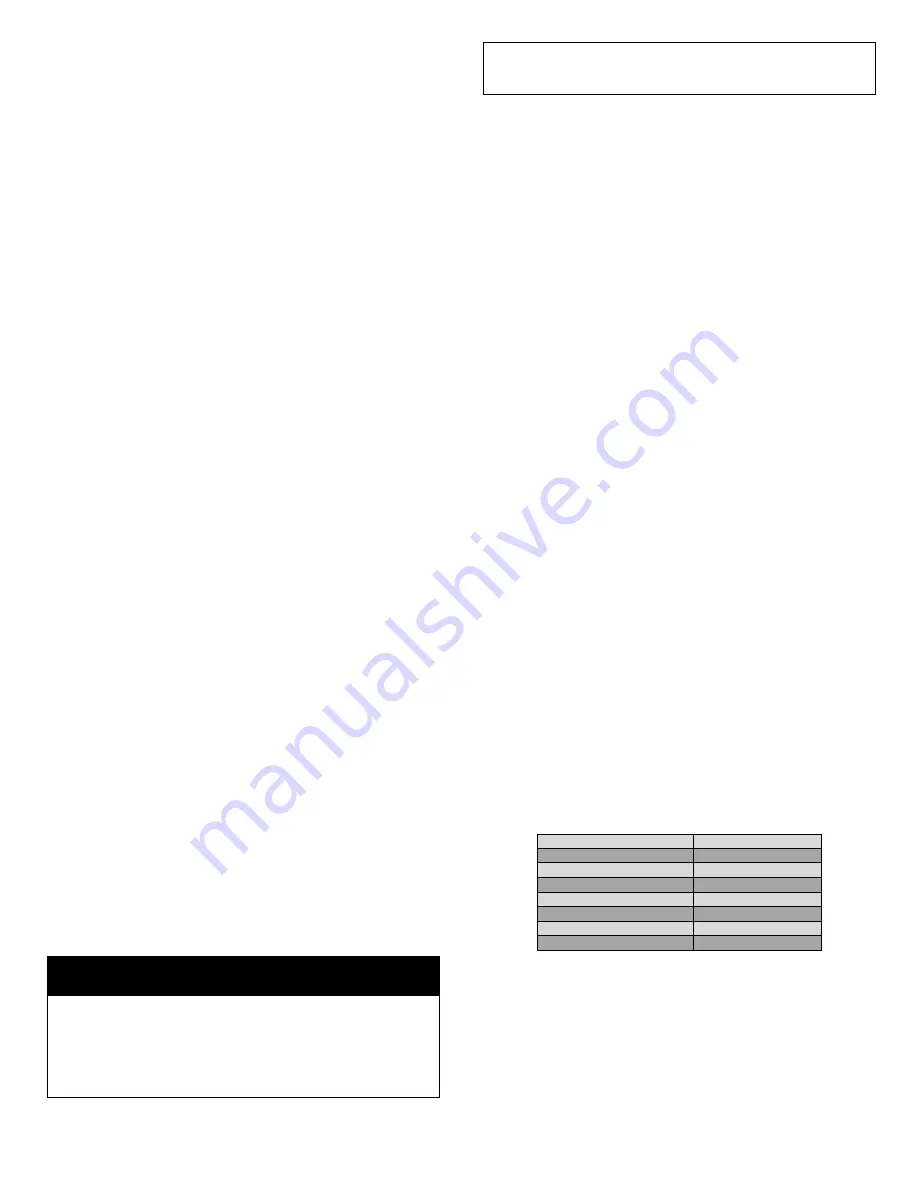
9
2.1.1-
Safety
USA:
National Fuel Gas Code (NFGC) NFPA 54-2009/ANSI Z223.1-
2009 and the Installation Standards, Warm Air Heating and Air
Conditioning Systems ANSI/NFPA 90B
CANADA:
National Standard of Canada, Natural Gas and Propane
Installation Code (NSCNGPIC) CAN/CSA B149.1-2010
2.1.2-
General installation
USA:
NFGC and the NFPA 90B. For copies, contact the National Fire
Protection Association Inc., Battery march Park, Quincy, MA
02269; or for only the NFGC contact the American Gas
Association, 400 N. Capitol, N.W.,Washington DC 20001
CANADA:
NSCNGPIC. For a copy, contact Standard Sales, CSA
International, 178 Rexdale Boulevard, Etobicoke (Toronto),
Ontario, M9W 1R3, Canada
2.1.3-
Combustion and air ventilation
USA:
Section 9.3 of the NFPA54/ANSI Z223.1-2009 Air for
Combustion and Ventilation
CANADA:
Part 8 of the CAN/CSA B149.1-2010, Venting Systems and Air
Supply for Appliances
2.1.4-
Duct systems
USA and CANADA:
Air Conditioning Contractors Association
(ACCA) (Manual D), Sheet Metal and Air Conditioning
Contractors National Association (SMACNA), or American
Society of Heating, Refrigeration, and Air Conditioning
Engineers (ASHRAE).
2.1.5-
Acoustical lining and fibrous glass duct
USA and CANADA
: current edition of SMACNA, NFPA 90B as tested by
UL Standard 181 for Class I Rigid Air Ducts.
2.1.6-
Gas piping and pipe pressure testing
USA:
NFPA 54/ANSI Z223.1-2009 NFGC; Chapters 5, 6, 7, and 8
and national plumbing codes.
CANADA:
CAN/CSA-B149.1-2010, Parts 4, 5, 6, and 9.
IN THE STATE OF MASSACHUSETTS:
This product must be installed by a licensed plumber or gas fitter.
When flexible connectors are used, the maximum length shall not
exceed 36
”. (914 mm).
When lever type gas shutoffs are used they shall be "T" handle
type.
The use of copper tubing for gas piping is not approved by the state
of Massachusetts.
2.1.7-
Electrical connections
USA:
National Electrical Code (NEC) ANSI/NFPA 70-2011
CANADA:
CAN/CSA-B149.1-2010, Parts 4, 5, 6, and 9.
2.2- ELECTROSTATIC DISCHARGE
CAUTION
FURNACE RELIABILITY HAZARD
Failure to follow this caution may result in unit component damage.
Electrostatic discharge can affect electronic components. Take
precautions during furnace installation and servicing to protect the
furnace electronic control. Precautions will prevent electrostatic
discharges from personnel and hand tools which are held during the
procedure. These precautions will help to avoid exposing the control to
electrostatic discharge by putting the furnace, the control, and the
person at the same electrostatic potential.
1)
Disconnect all power to the furnace. Multiple disconnects may be
required. DO NOT TOUCH THE CONTROL OR ANY WIRE
CONNECTED TO THE CONTROL PRIOR TO DISCHARGING
YOUR BODY’S ELECTROSTATIC CHARGE TO GROUND.
2)
Firmly touch the clean, unpainted, metal surface of the furnace
chassis which is close to the control. Tools held in a person’s
hand during grounding will be satisfactorily discharged.
3)
After touching the chassis, you may proceed to service the
control or connecting wires as long as you do nothing to recharge
your body with static electricity (for example; DO NOT move or
shuffle your feet, do not touch ungrounded objects, etc.).
4)
If you touch ungrounded objects (and recharge your body with
static electricity), firmly touch a clean, unpainted metal surface of
the furnace again before touching control or wires.
5)
Use this procedure for installed and uninstalled (ungrounded)
furnaces.
6)
Before removing a new control from its container, discharge your
body’s electrostatic charge to ground to protect the control from
damage. If the control is to be installed in a furnace, follow items
1 through 4 before bringing the control or yourself in contact with
the furnace. Put all used and new controls into containers before
touching ungrounded objects.
7)
An ESD service kit (available from commercial sources) may
also be used to prevent ESD damage.
2.3- LOCATION
General
These furnaces are shipped with materials to assist in proper furnace
installation. These materials are shipped in the main blower compartment.
See Table 2 Loose parts list for loose parts bag contents. This furnace
must:
Be installed so the electrical components are protected from water;
Not be installed directly on any combustible material other than
wood flooring;
Be located close to the chimney or vent and attached to an air
distribution system. Refer to section 5 Ducts section;
Be provided ample space for servicing and cleaning. Always
comply with minimum fire protection clearances shown in Table 1
Minimum
clearance
to
combustible
material
for all units or on the furnace rating label.
Table 1 Minimum clearance to combustible material
for all units
Position
Clearance in (mm)
Rear
0
Front
0
Required for service (front)
*24'' (610)
All sides of supply plenum
*1''(25)
Sides
0
Vent
0
Top of furnace
1''
*See local buildings codes.
Summary of Contents for c105-1-d
Page 20: ...20 Figure 16 Wiring diagram One stage PSC ...
Page 21: ...21 Figure 17 Two Stage PSC Furnace Control ...
Page 22: ...22 Figure 18 Two Stage ECM Furnace Control ...
Page 26: ...26 Figure 21 Direct venting Figure 22 Multi venting ...
Page 37: ...37 Figure 25 Part list 1 Stage PSC ...
Page 38: ...38 Figure 26 Part list 1 Stage PSC continued ...
Page 41: ...41 Figure 27 Part list 2 Stage PSC ...
Page 42: ...42 Figure 28 Part list 2 stage PCS continued ...
Page 45: ...45 Figure 29 Part list X13 ...
Page 46: ...46 Figure 30 Part list X13 continued ...
Page 49: ...49 Figure 31 Part list 2 Stage ECM ...
Page 50: ...50 Figure 32 Part list 2 Stage ECM continued ...







































